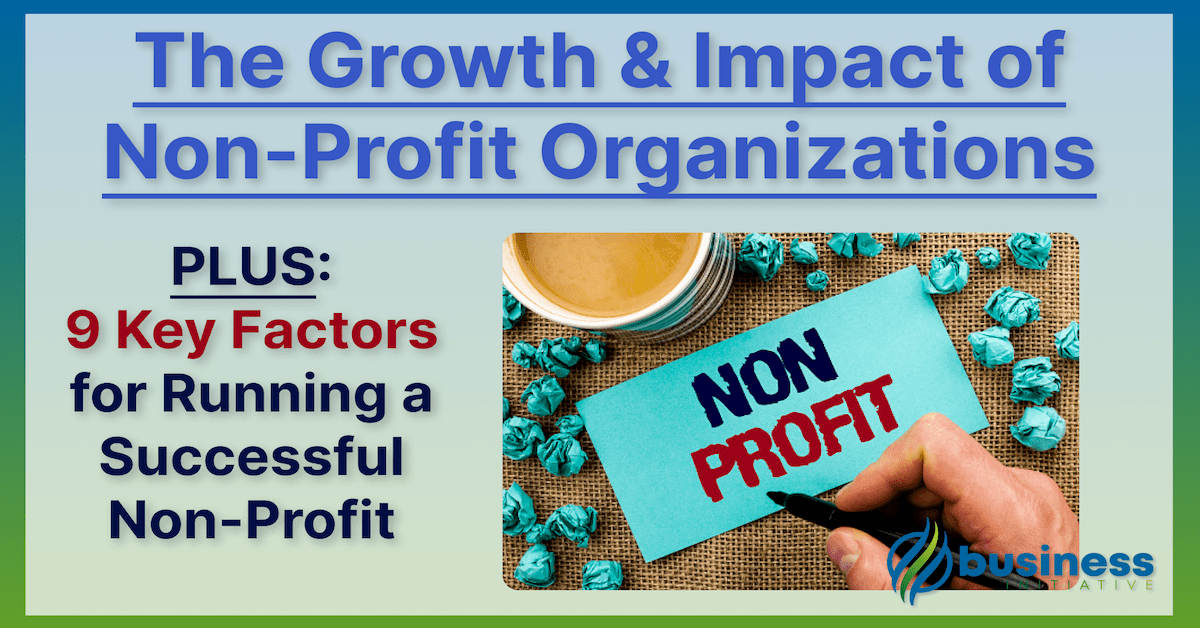Non-profit organizations play a critical role in our society by addressing social, environmental, and economic issues.
With nearly 1.6 million non-profit organizations registered in the United States alone, this sector has experienced significant growth and impact over the past few decades.
Entrepreneurs and business owners interested in starting a non-profit can learn about the opportunities and challenges in this sector by examining growth trends, sector-specific impact, and success factors.
This article will take you on a data-driven journey through the world of non-profit organizations and provide valuable insights to help you make informed decisions.
Growth Trends in the Non-Profit Sector
The non-profit sector has experienced tremendous growth over the past few decades.
According to data from the National Center for Charitable Statistics, the number of non-profit organizations in the United States increased by 32% between 2000 and 2020, from 1.2 million to nearly 1.6 million.
This growth has been driven by various factors, including increased public awareness, government support, and the rise of social entrepreneurship.
Globally, the non-profit sector has also seen significant growth, highlighting the increasing importance of non-profit organizations in addressing global challenges and improving people’s lives.
Sector-Specific Impact of Non-Profit Organizations
Non-profits impact various sectors, including education, healthcare, social services, and environmental conservation.
Let’s take a closer look at how non-profits are making a difference in these areas:
1. Education:
Non-profit organizations play a pivotal role in enhancing the quality of education and increasing access to learning opportunities.
For instance, organizations like Teach for America and Room to Read have made substantial impacts on educational outcomes in the United States and around the world.
These organizations work with communities and governments to develop innovative solutions to education challenges, ultimately benefiting millions of children.
2. Healthcare:
Non-profits have been instrumental in improving healthcare access and outcomes, particularly in low-income communities.
Organizations like Partners in Health and the Bill & Melinda Gates Foundation have contributed significantly to global health initiatives, including combating epidemics and promoting vaccination campaigns.
Their efforts have saved countless lives and improved overall public health.
3. Social Services:
Many non-profits provide essential social services to vulnerable populations, including food assistance, housing support, and mental health services.
Groups like Feeding America and Habitat for Humanity have made a significant impact in addressing these critical needs.
These organizations offer a lifeline for those struggling to make ends meet and promote social cohesion and well-being.
4. Environmental Conservation:
Non-profit organizations are at the forefront of environmental conservation and sustainability efforts.
Organizations like The Nature Conservancy and the World Wildlife Fund work tirelessly to protect natural habitats, promote sustainable practices, and address climate change. Their work ensures a healthier planet for future generations.
9 Factors for operating a Successful Non-Profit Organization
Several factors contribute to the success of non-profit organizations, including clear mission and goals, effective leadership, transparent governance, and strong community engagement.
Successful non-profits typically exhibit the following characteristics:
🔑 1. Clear Mission and Goals:
A well-defined mission statement and strategic goals provide a strong foundation for non-profit organizations.
It helps stakeholders understand the organization’s purpose and guides decision-making processes.
🔑 2. Effective Leadership:
Strong leadership is essential for non-profit success.
Effective leaders inspire and motivate their team, create a positive work environment, and foster a culture of innovation and collaboration.
🔑 3. Transparent Governance:
Transparency and accountability are crucial for building trust with stakeholders, including donors, volunteers, and beneficiaries.
Successful non-profits prioritize good governance practices, such as regular financial reporting and ethical conduct.
🔑 4. Strong Community Engagement:
Building strong relationships with the communities they serve is vital for non-profit organizations.
This engagement helps non-profits understand local needs, create tailored solutions, and mobilize resources effectively.
🔑 5. Diversified Funding Sources:
Successful non-profits explore various funding streams, including grants, individual donations, corporate sponsorships, and social enterprises.
A diversified funding strategy ensures financial stability and reduces dependency on a single source.
🔑 6. Measurable Impact:
Demonstrating the organization’s impact through data-driven evaluations and assessments is crucial for attracting support and maintaining credibility.
Effective non-profits regularly track progress towards their goals and use this information for continuous improvement.
🔑 7. Strategic Partnerships and Collaboration:
Forming strategic partnerships with other organizations, both within the non-profit sector and beyond, can help amplify impact and extend reach.
Successful non-profits actively seek collaborations to share resources, knowledge, and expertise for mutual benefit.
🔑 8. Adaptability:
Non-profit organizations must be agile and adaptable to navigate changing circumstances, such as shifting community needs or evolving regulations.
Embracing change and being open to new approaches enables successful non-profits to stay relevant in a dynamic environment.
🔑 9. Effective Communication:
Clear communication with stakeholders is essential for building trust, raising awareness of the organization’s work, and mobilizing support.
Successful non-profits invest in effective communication strategies that resonate with their target audiences – from compelling storytelling to impactful visual content.
In Summary…
The growth and impact of non-profit organizations in various sectors cannot be overstated.
By addressing pressing social, environmental, and economic issues, non-profits play a critical role in shaping a better world for all.

If you are an entrepreneur or business owner considering starting a non-profit, understanding growth trends, sector-specific impact, and success factors can help you navigate the exciting world of social change and impact.
Ready to Take Initiative?
Reach out NOW and let’s get your Non-Profit up an running…


